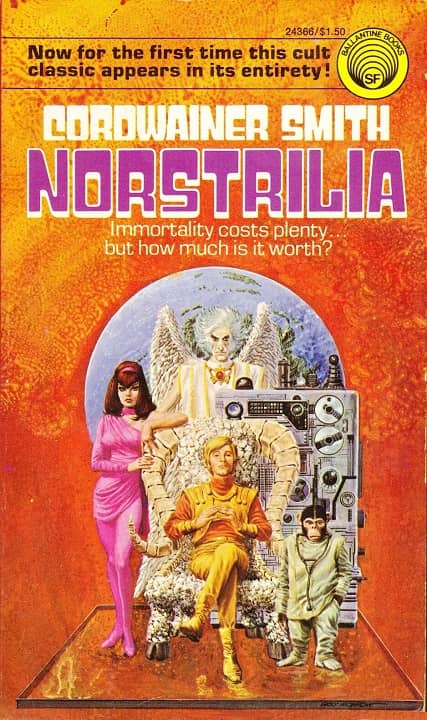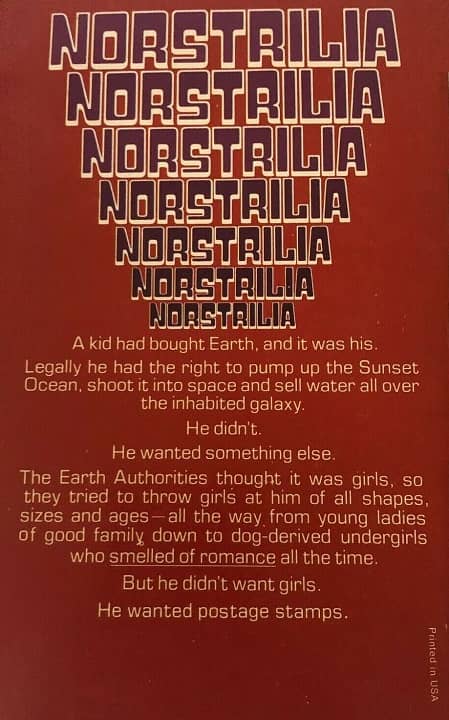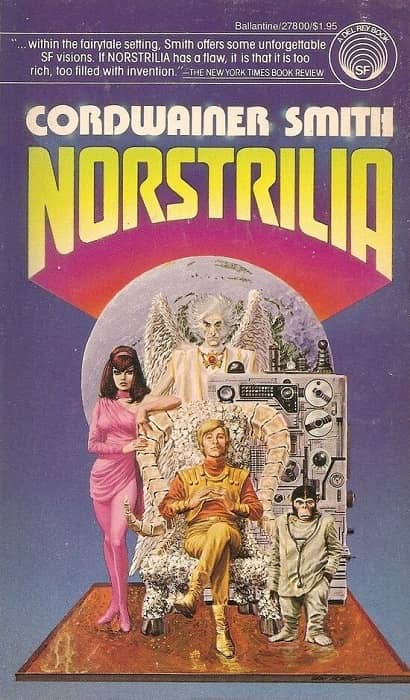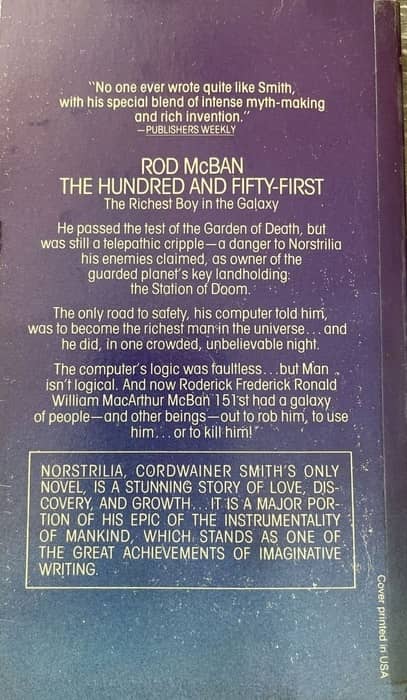Alan Brown on Cordwainer Smith’s Classic Norstrilia
 |
 |
First paperback release of Norstrilia (Ballantine, 1975), with the infamous “dog-derived undergirls”
back cover text (they “smelled of romance all the time.”) Cover by Gray Morrow
For the past six years Alan Brown has had an entertaining biweekly series at Tor.com on our favorite topic — vintage SF & fantasy. He’s covered Keith Laumer’s Bolo, Poul Anderson’s Flandry of Terra, Andre Norton’s The Beast Master, Joe Haldeman’s The Forever War, Spider Robinson’s Callahan’s Crosstime Saloon, David Brin’s Startide Rising, and about a jillion others.
Last week he took a look at Cordwainer Smith’s classic 1975 novel Norstrilia, originally published as two shorter works, The Planet Buyer (1964) and The Underpeople (1968). According to fannish legend, Smith’s publishers at Pyramid Books in the 60s felt it was too long, so he obliged them by breaking it up into two smaller novels. It was eventually published in the original format, under the title Norstrilia, by Lester del Rey at Ballantine Books in 1975.
 |
 |
The 1978 paperback reissue, with revised back cover text. Note the blue recoloring.
Cordwainer Smith seems to be having a bit of a moment. I’m seeing a lot of recent attention on social media, in the fan press, and even right here at Black Gate (just last week the esteemed Rich Horton looked back at Smith’s first published SF story, the famous “Scanners Live in Vain.“)
It’s certainly well deserved. Smith’s sprawling Instrumentality of Mankind — a Future History he built up over a decade, primarily with short fiction — is one of the most enduring achievements of 20th Century SF. Here’s Alan.
His stories of the Instrumentality of Mankind were intriguing, giving the reader science fiction tales with the storytelling conventions of fantasy and legend. And in the centerpiece of this future history, the novel Norstrilia, he brought young and naïve Rod McBan to the mysterious and dangerous planet called Earth… The work of Cordwainer Smith was not new to me when I found Norstrilia, as I had read some of his work in my dad’s Galaxy magazines during my youth. I had always found his stories intriguing, if a bit strange compared to the more straightforward adventures I was used to reading in Analog…
We meet young Rod McBan, 151st of his name, who is on the cusp of inheriting the family ranch, the ominously named Station of Doom, where giant sickly sheep produce the precious drug called stroon… Now, he must face what is called the Garden of Death, a trial that determines whether Norstrilians will be executed by drugs that kill them with happiness, or allowed to go on with their lives. His only friends are an old battle computer, hidden on the farm, which has educated him over the years, and his cousin Lavinia, one of the few people who is comfortable speaking to him with her voice in the old manner.
Rod’s trial board consists of three people, two local, and one surprisingly the Lord Redlady, a Commissioner of the Instrumentality. Redlady convinces the board that Rod’s different abilities are not a liability, but rather a gift. And he is allowed to live.
Rod’s survival angers an old childhood adversary, who is now a government official with the title of Onseck, a corruption of the ancient term Honorary Secretary. The Onseck has placed blocks on Rod’s inheritance of the Station of Doom. Rod visits his computer, which suggests that, working together, they could corner the market on stroon, making Rod richer and giving him more power over his destiny. They succeed beyond their wildest dreams, and after a long trading session, Rod finds himself not only the richest man in civilization, but also owner of the planet Earth. Being incredibly rich turns out to bring problems of its own….
Cordwainer Smith is a writer who should not be forgotten. His work was rich and fascinating, and unlike the output of many other writers of his era, his tales have aged like a good whiskey.
Read the complete article here, and check out all of Alan’s classic SF reviews at Tor.com here.
Norstrilia proved very popular, and Ballantine kept it in print for the better part of a decade. They revamped the design and cover text multiple times, doing away with the sexist and frankly ridiculous description on the back of the 1975 paperback edition, with its focus on “dog-derived undergirls” (see rec cover at top), and finally settling on back cover copy that focused rather on the author’s accomplishment with The Instrumentality of Mankind (see blue covers above).
If you’re curious about Cordwainer Smith (or science fiction collecting in general), check out Christopher Rowe’s recent Facebook posts as he chronicles his determined efforts to track down all of Smith’s work in its original form.
Norstrilia was published by Ballantine Books in February 1975. It is 277 pages, priced at $1.50. The cover is by Gray Morrow. It has been reprinted many times, most recently in 2016 as part of the Gollancz SF Masterworks imprint.
See all our recent coverage of Vintage SF & Fantasy here.
Thanks for the shoutout, John! I now have all the magazine appearances and first editions of all eleven books in twenty-seven editions published in the US under the Smith byline except for a couple of small press trade paperbacks that I have the hardcovers of and the 1975 edition of the first collection, You Will Never Be the Same, from the Garland Library of Science Fiction. That last one is going to have to wait until my next contract comes, hah! I’ve found diving deep into Smith’s life and work deeply rewarding, and highly recommend at least reading the collected stories and the novel as put out by NESFA Press to anyone interested in science fiction.
Perhaps shockingly, I haven’t reread NORSTRILIA since shortly after that 1975 Ballantine edition came out. But as noted I am going through a Cordwainer Smith phase now, and so I will be remedying that soon! I’m tempted to do it by buying the original paperbacks of THE PLANET BUYER and THE UNDERPEOPLE, or perhaps I could go full Christopher Rowe and start with “The Boy Who Bought Old Earth” and “The Store of Heart’s Desire”.
I have the two NESFA Smith volumes. He’s a great writer but not the most inviting one; I always feel that I have to steel myself to read him (if not “gird my loins.”)